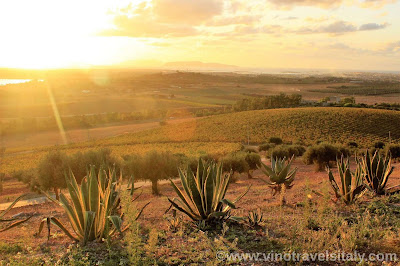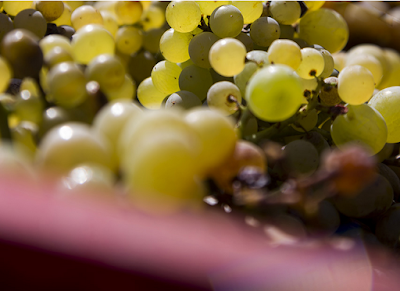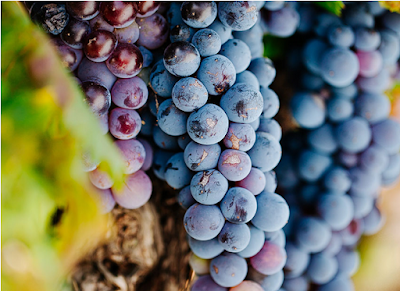Sicily is one of the fascinating wine regions of Italy, although we could probably make that statement for many others as well. Sicily is Italy’s largest island and has a rich history of various cultural influences from Greeks and Romans to Phoenicians, Arabs and more. These influences can be seen throughout Sicily’s architecture, food and wine to name a few.
 |
| Western Sicily in Trapani |
Sicily’s unique terrain of coastal Mediterranean influences lined with pristine beaches to hills and Italy’s most active volcano, Mt. Etna, along with surrounding islands to include Pantelleria and the Aeolian Islands that contain additional active volcanos like Vulcano and Stromboli.
 |
| Landscape of Mt. Etna |
Sicily’s White Grapes
There is a vast array of white grapes that you can find produced in Sicily, including some international varieties as well, but there are a number of them that lead the way in production. These grapes are Catarratto, Carricante, Grillo, Inzolia, Zibibbo and Malvasia di Lipari.
Catarratto is the most widely white grape planted in Sicily and is primarily planted around the western side of Sicily in the province of Trapani. It is an ancient grape and one of the oldest of Sicily. This was once used as the primary base in the fortified Marsala wines. It’s a grape that produces large yields and because of that is sometimes exported in bulk or produces every day wines or is used a blending grape. It is said to be genetically related to the grape, Garganega, of northern Italy used in producing Soave wines. Catarratto typically produces, dry, light bodied wines that have good acidity with citrus notes.
 |
| Sourced from the Consorzio Etna DOC |
Grillo is a grape that wasn’t prevalent much before the 19th century, but over time has become the primary grape used in produced Marsala slowing replacing Catarratto. Grillo’s skins and characteristics make it a great grape for producing Marsala. It has great color, a nuttiness and a tendency to be a grape that can oxidize. There are many producers that are also using this grape to make still wines that a creamier mouthfeel with tropical notes.
Carricante’s home is found on the slopes of Mt. Etna climbing up to high altitudes. Although it may not be labeled as such, if you see wines labeled Etna Bianco Carricante will be the primary grape used. It is a late ripening grape that is known for its heightened acidity levels. It produces dry, crisp wines with citrus and herbal notes.
 |
| Sourced from the Consorzio Etna DOC |
The last 2 white grapes I’m sharing today are typically found in Sicilian dessert wines, but can also be produced in a dry style. Zibibbo, which I shared on last week’s blog with Donnafugata’s Ben Rye, is also known as Muscat di Alexandria. It seems from the Arabic word zabib, which means raisened or dried grapes, which is how this wine is produced when produced as a dessert style wine as the grapes are dried out on mats. You will mostly see this wine grown on the island of Pantelleria found on the western coast off the northern tip of Africa.
 |
| Sourced from the Consorzio di Pantelleria |
The other white dessert style grape is Malvasia di Lipari. This is grown on the volcanic Aeolian islands north of Sicily. Lipari is actually the largest of Sicily’s islands. Malvasia is produced in a passito style and is found under the Malvasia delle Lipari DOC with a sweet touch of apricots and honey. Another sipper after an evening meal.
Sicily’s Red Grapes
When it comes to Sicily’s red grapes, Nero d’Avola leads the pack. If you’ve ever shopped for Sicilian wines this is probably the one you’ve come across the most. The grape is named after the town of Avola found on the southeastern side. It is also known as Calabrese, which stems from the Sicilian dialect, Calavrisi. Nero, means black, and is perfectly named for the deep color it lends to the glass. A medium to full bodied wine with high alcohol and juicy acidity. It can have milder tannins with red and dark fruits, pepper and spice. This wine can be found blended with Frappato in the Cerasuolo di Vittoria DOCG wines, the only DOCG of the island.
There are 2 Nerello grapes that are typically blended together, Nerello Mascalese and Nerello Cappuccio. These are both grapes that are native to Mt. Etna. Nerello Mascalese is the primary grape of the area and 2nd most planted red grape in Sicily. The name derives from the town of Mascali on the eastern side of Etna. It is a late ripening grape that is lighter colored, but carries good acidity, high alcohol with earthy characteristics along with red fruits, some spice and minerals. Mostly you will find these grapes labeled under Etna Rosso wines. Nerello Cappuccio on the other hand is not as prevalent and is mostly to add rich color to its counterpart and helps soften the wines.
 |
| Sourced from the Consorzio Etna DOC |
Frappato is a great red wine that depending on the producer is produced alone or blended with other grapes. It is mostly grown around Vittoria in the southeastern part of Sicily. It is a beautifully perfumed with that is light in body with lower tannins and juicy acidity. If you’re sometimes looking for a red in the summertime that doesn’t pack a heavily bodied punch then give Frappato a look.
Lastly, the Perricone grape I really came to love on my last visit to Sicily in 2019 before the pandemic hit. Perricone is a grape that has been around since before phylloxera, but did at one point face extinction like many other grapes of Italy. A number of producers that are now working with it of which I’m thankful for. It is also known as Pignatello and is a grape that gives great color, tannin and texture with red and dark fruits along with herbal notes. As mentioned before you will see this blended with Nero d’Avola often, but there are producers that make Perricone on its own seen in my previous post on Firriato’s Perricone.
What are your favorite Sicilian grapes?
No comments:
Post a Comment